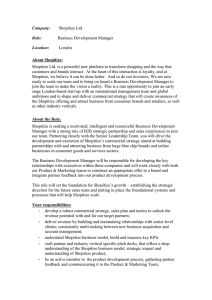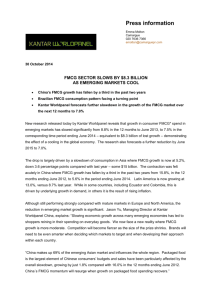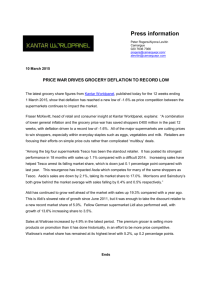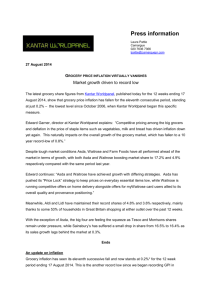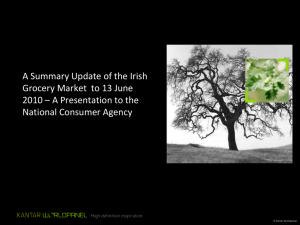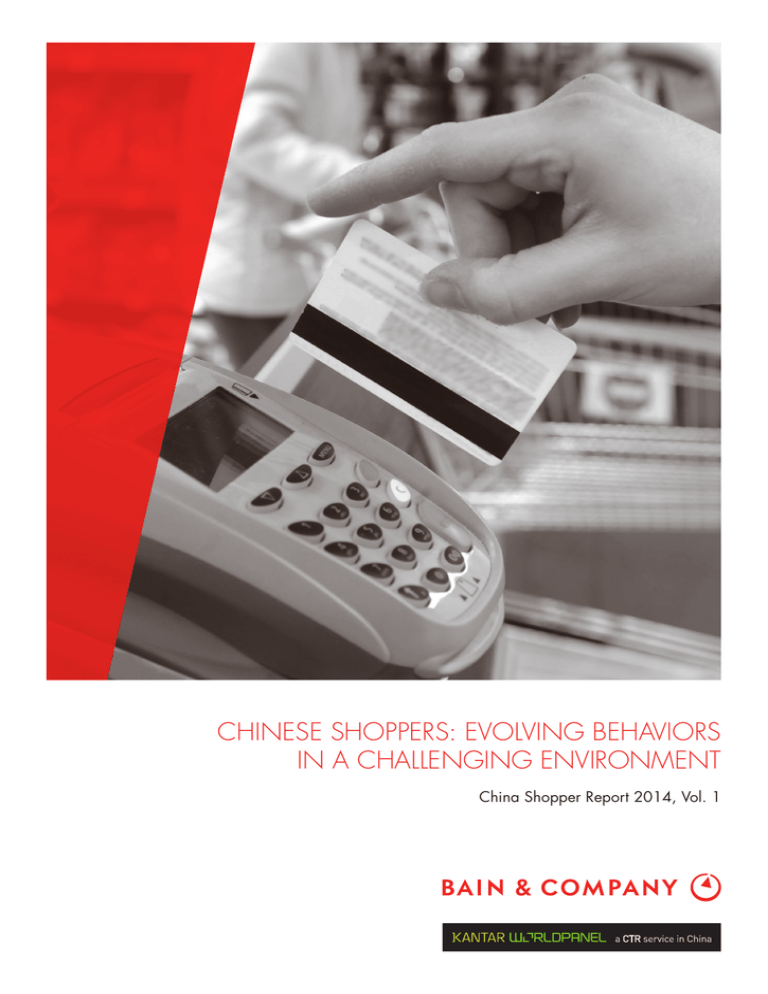
Chinese shoppers: Evolving behaviors
in a challenging environment
China Shopper Report 2014, Vol. 1
Copyright © 2014 Bain & Company, Inc. and Kantar Worldpanel
All rights reserved.
Chinese shoppers: Evolving behaviors in a challenging environment | Bain & Company, Inc. | Kantar Worldpanel
Contents
1.
Executive summary . . . . . . . . . . . . . . . . . . . . . . . . . . . . . . . . . . . . . . . . . . . 1
2.
Chinese shoppers: Evolving behaviors in a challenging environment
a. China’s decelerating FMCG market . . . . . . . . . . . . . . . . . . . . . . . . . . . . . 5
b. Challenging offline and booming online . . . . . . . . . . . . . . . . . . . . . . . . . . 9
c. Chinese vs. foreign brands: Winners and losers . . . . . . . . . . . . . . . . . . . . 15
3.
About the authors and acknowledgments . . . . . . . . . . . . . . . . . . . . . . . . . . . 20
Page i
Chinese shoppers: Evolving behaviors in a challenging environment | Bain & Company, Inc. | Kantar Worldpanel
Page ii
Chinese shoppers: Evolving behaviors in a challenging environment | Bain & Company, Inc. | Kantar Worldpanel
Executive summary
The growth of the fast-moving consumer goods (FMCG) market continued to slow in China in 2013. Fierce competition among brands and thriftier shoppers mean that marketers can no longer grow a brand just by riding a
category wave. Gaining market share is imperative, and market penetration is the primary way to achieve it, as
we established in our 2012 and 2013 China Shopper Reports.
For the third year, Bain & Company partnered with Kantar Worldpanel to study the shopping behaviors of 40,000
Chinese households. Our unconventional approach assigned research participants with barcode scanners to determine what they actually purchased, as opposed to what they said they had purchased.
We studied 106 FMCG categories and analyzed in detail 26 categories spanning the four largest consumer goods
sectors: personal care, home care, beverage and packaged food, which account for more than 80% of China’s
FMCG market in value. Our study helped us gain invaluable insights into how shoppers make purchases in these
26 important consumer goods categories.
Building on the research we began in 2012, we continue our exploration of the major trends affecting China’s FMCG
market in this year’s China Shopper Report. This is the first of two volumes and focuses on three key trends:
•
Continuing deceleration of China’s FMCG market across sectors and all city tiers
•
Fewer store visits to offline retailers as online commerce boomed
•
Foreign brands’ continued loss of aggregate share to Chinese brands for the 26 categories we analyzed
China’s decelerating FMCG market
Growth continued to slow across all the FMCG sectors we studied—packaged food, beverage, personal care and
home care—and across all city tiers, though lower-tier cities grew at higher rates. In higher-tier cities, which are
still the primary markets for FMCG, growth declined from 2012 to 2013 compared with growth from 2011 to 2012.
In Tier 1, it dropped from 8.6% to 3.5%; in Tier 2, from 10.7% to 7.4%; and in Tier 3, from 12.4% to 8.4%.
FMCG growth, which was 15% nearly three years ago and around 12% in 2012, slowed to 4.6% in the first quarter
of 2014. That trend suggests mid-single-digit growth ahead—though China’s annualized FMCG growth still remains higher than growth in many other Asian markets.
One reason for the deceleration: The pace of premiumization slowed noticeably. In the past, the FMCG market
grew as a result of price increases, new product innovations and the introduction of more premium SKUs at
higher price points. With premiumization slowing, price increases fell sharply across all four sectors.
The good news is that volume growth across sectors remained stable with the exception of packaged food. In the
beverage sector, volume growth increased from 2.7% to 3.9%. For both personal care and home care, the 6%
growth in 2013 was similar to that in 2012. And in packaged food, growth decreased from 5.5% to 2.6%, because
an unusually long, hot summer affected sales.
Page 1
Chinese shoppers: Evolving behaviors in a challenging environment | Bain & Company, Inc. | Kantar Worldpanel
Though the growth of disposable income and annual spending per household decreased, according to China’s
National Bureau of Statistics, the number of urban households steadily increased at 2.6% per year, contributing
to volume growth.
Challenging offline and booming online
Offline shopping channels represented 97% of all FMCG purchases, as purchasing behaviors continued to shift
toward modern trade, which mainly includes supermarkets and hypermarkets.
Modern trade accounted for more than 50% of FMCG market value. Growing at a brisk 10% per year, it has surpassed traditional trade in scale and growth, gradually taking more share in purchase occasions and spending—
a trend consistent across all city tiers.
Hypermarkets saw store visits per household decline in the past two years, from 26 visits per year per household in 2011 to 25 visits in 2012 and 2013. Smaller modern trade formats—supermarkets, convenience stores
and personal care stores—saw no decrease in visits at 23 per year per household. Declining hypermarket visits,
however, were offset by larger package size and with increased car ownership in major Chinese cities making it
convenient for shoppers to purchase and transport larger items.
Another reason hypermarket visits declined: The growth of prepaid cards for retail use slowed. Prepaid cards,
which are given to Chinese consumers as public welfare or as gift cards, are used mainly in hypermarkets, supermarkets and department stores. The slowdown in their use was the result of the Chinese government’s anticorruption efforts targeting card misuse.
The online FMCG channel, though nascent, is booming, as Chinese shoppers are more willing than shoppers in
other markets to use their smartphones and PCs to make purchases. As a result, China is now the No. 1 digital
retail market in the world in both value and penetration, with momentum expected to continue. All 106 categories
we studied enjoyed high online growth—42% overall. Young urban households in higher-tier cities with incomes
of more than RMB 7,000 per month make up the largest percentage of e-commerce shoppers. Consistent with
previous years, baby products and beauty products are highly penetrated categories with high online value share.
Chinese vs. foreign brands: Winners and losers
Fierce competition from Chinese companies in 2013 resulted in foreign brands losing overall share across the
26 categories we studied in detail. But the picture is different by category: While foreign brands lost share in many
categories, including carbonated soft drinks, skin care, juice and infant formula, they achieved marginal share
gain in some categories, such as hair conditioner and biscuits.
Nonetheless, on balance, 60% of the foreign brands we studied lost share this year; many even lost share in the
categories in which foreign brands experienced overall share gains. The share loss occurred across all city tiers—
even higher-tier cities, where foreign brands enjoyed a relatively strong presence.
As one could expect, this change in market share is driven by change in penetration.
Page 2
Chinese shoppers: Evolving behaviors in a challenging environment | Bain & Company, Inc. | Kantar Worldpanel
Implications: The market share imperative
As Chinese shopper behaviors continue to shift and evolve, marketers can no longer coast by simply riding a
category wave. Growth must come primarily from share gain. And penetration change is the most important way
to achieve share change.
Our first volume of the 2014 China Shopper Report by Bain & Company and Kantar Worldpanel, along with the
2012 and 2013 reports, shows that marketers must drive penetration to gain market share. In an upcoming volume, to be released in the fall of 2014, we will share more details about how marketers can do this.
Building penetration depends on continually building brand consideration—the percentage of consumers who
consider your brand for a purchase occasion—which in turn helps increase penetration. The steady path for earning consideration and penetration requires investment in three brand assets:
•
Memory structures. By using the full range of above-the-line (ATL) and below-the-line (BTL) marketing touchpoints, marketers can anchor a brand in consumers’ long-term memories. Winning companies broadcast
distinct, memorable messages to the largest possible swath of consumers.
•
Product portfolios. Too many brands and SKUs can result in ineffective advertising, shopper confusion and
other perception woes that erode penetration. Surprisingly few innovations result in increased penetration.
They fail at a high rate and distract marketing and commercial teams from supporting core SKUs. Winning
brands identify critical “hero” SKUs that have the highest potential to win with shoppers.
•
In-store assets. Once you target the most important SKUs, it’s essential to adequately invest to activate them
at the point of sale and ensure they’re always available at the right place on the shelf. Leading companies
identify which store assets are critical to own in their category.
Given that China is now the world’s No. 1 digital retail market, marketers—especially those in the leading online
categories—will benefit from developing an e-commerce business model. The online channel can be used as an
incremental channel to further build these three brand assets and expand business, while minimizing cannibalization with offline channels.
Though e-commerce is booming, offline channels are still the main battlefield. It’s critical for marketers to maximize offline business potential by leveraging online traffic through effective digital marketing and integrated
solutions—what’s known as “O2O” (online to offline).
Page 3
2a.
China’s decelerating
FMCG market
•
FMCG growth continued to slow across all sectors
we studied (packaged food, beverage, personal care
and home care).
•
In the first quarter of 2014, FMCG growth slowed to
4.6%, the lowest in three years and a big drop from
the 15% growth it saw in the second quarter of 2011.
•
One reason for decelerating growth: The pace of premiumization slowed, and as a result, price increases
in 2012 to 2013 were smaller than the increases in
2011 to 2012 across all four sectors. Price increases
for packaged food dropped from 5.5% to 2.5%; for
beverage, from 9.9% to 6.8%; for personal care,
from 4.1% to 1.6%; and for home care, from 4.7%
to 0.2%. Worse, some sectors, in particular, personal
care and home care, had average selling price increases that fell below the 2.6% inflation rate.
•
Volume growth was more stable, with the exception of
the packaged food sector, where sales were affected
by an unusually long, hot summer in 2013. Volume
growth in packaged food declined from 5.5% to 2.6%,
while volume growth in the beverage sector increased
from 2.7% to 3.9%.
•
The overall slowdown in the FMCG category over the
last two years is mostly a result of a decrease in annual
spending per household—a drop from 9% in 2012 to
4.6% in 2013—while the number of households continued to increase at approximately 2.6% per year.
•
FMCG growth consistently slowed across all city tiers,
though in lower-tier cities it grew at higher rates.
Higher-tier cities, still the primary markets for FMCG,
saw declining growth—in Tier 1 decreasing from
8.6% to 3.5%; in Tier 2, from 10.7% to 7.4%; and
in Tier 3, from 12.4% to 8.4%.
•
China’s FMCG growth slowed from 11.8% in 2012
to 7.4% in 2013; however, it is still higher than FMCG
growth in many other Asian markets.
Chinese shoppers: Evolving behaviors in a challenging environment | Bain & Company, Inc. | Kantar Worldpanel
Figure 1: Influenced by the macro economy, China’s FMCG market growth has slowed, trending toward
mid-single-digit growth
Annual growth of urban shoppers’ total spending on FMCG
20%
15
10
5
0
11Q2
11Q3
11Q4
12Q1
12Q2
12Q3
12Q4
13Q1
13Q2
13Q3
13Q4
14Q1
YoY growth of disposable
income per capita in
urban areas (%)
14.2
14.9
15.4
14.0
12.5
12.5
11.4
9.3
8.9
10.2
10.6
9.8
Total FMCG
Food and beverage
Personal and home care
Notes: This study tracked household take-home consumption and covered 20 provinces and four direct-controlled municipalities in mainland China (excludes Hong Kong, Macau
and Taiwan); the number of households in Tier-5 cities was adjusted in 2013 and restated for 2011–12, resulting in slightly different 2011−12 data from previous reports; data
covers 106 FMCG categories (includes ambient and chilled food and beverages, and personal care and household products; excludes fresh food, white goods and electronics)
Sources: Kantar Worldpanel; Bain analysis
Figure 2: The upside: Despite the slowdown, China’s FMCG market growth is still higher than that
in many other Asian markets
Annual growth of China’s urban FMCG
retail market, 2011–13
RMB 1,500B
CAGR
11.8%
1,000
CAGR
7.4%
1,068
Annual growth of other major Asian urban
FMCG retail markets, 2011–13
15.0
14.3
15%
14.0
1,146
955
11.8
11.0
10
9.8
9.0
7.7
500
0
7.4
7.4
5
2011
2012
2013
0
4.0
7.3
5.3
4.8
3.3
2.4
1.7
0.2
Vietnam*
Thailand
Indonesia
2013
inflation
rate (%) 6.6
8.4
Taiwan
Mainland China
2.2
2.6
0.8
South Korea
India
9.0
Japan
Malaysia**
1.3
2.1
-0.1
Philippines
0.4
3.0
*Data is from four urban cities in Vietnam
2011–2012
2012–2013
**Data is for Peninsular Malaysia
Notes: CAGR is compound annual growth rate; all FMCG categories were used for cross-country comparison; inflation rates are based on Consumer Price Indexes; 2011–12 data
for Japan is not included
Sources: Kantar Worldpanel; Bain analysis
Page 6
Chinese shoppers: Evolving behaviors in a challenging environment | Bain & Company, Inc. | Kantar Worldpanel
Figure 3: Falling prices caused the market growth slowdown, but volume growth remained steady, except
in the food sector
Annual growth of urban FMCG market, 2011–13
Value
Volume*
Average selling price*
15%
China’s inflation
rate = 2.6%**
12.9
11.8
11.3
10.9 11.3
11.2
9.9
10
7.8
7.4
6.2
5.5
5.2
5
7.0
6.1
4.1
3.8
2.6
7.4
6.16.1
6.8
5.5
3.9
2.7
3.4
4.1
4.7
2.5
1.6
0.2
0
Total
FMCG
Food
Beverage Personal
care
Home
care
Total
FMCG
Food
Beverage Personal
care
2011–2012
Home
care
Total
FMCG
Food
Beverage Personal
care
Home
care
2012–2013
*The units for volume are 1 kilogram for packaged foods, 1 liter for beverages, 10 rolls or 1,000 sheets for toilet tissue, 1,000 sheets for facial tissue, 100 pieces for baby
diapers, 1 package for skin care products or color cosmetics and 1 piece for toothbrushes; the average selling price is also based on these units
**China’s inflation rate was 2.6% for both 2012 and 2013
Notes: Data covers 106 FMCG categories (includes ambient and chilled food and beverages, and personal care and household products; excludes fresh food, white goods
and electronics)
Sources: Kantar Worldpanel; Bain analysis
Figure 4: FMCG growth consistently slowed across city tiers, though lower-tier cities achieved higher
growth rates
Channel value share in urban FMCG retail market
100%
80
60
RMB 955B
RMB 1,068B
RMB 1,146B
15%
15%
15%
13%
14%
14%
31%
32%
32%
40
26%
26%
26%
20
0
14%
14%
13%
2011
2012
2013
CAGR
CAGR
(11–12) (12–13)
11.8%
7.4%
Tier 5
13.8%
8.3%
Tier 4
13.6%
7.9%
Tier 3
12.4%
8.4%
Tier 2
10.7%
7.4%
Tier 1
8.6%
3.5%
Notes: Data covers 106 FMCG categories (includes ambient and chilled food and beverages, and personal care and household products; excludes fresh food, white goods
and electronics)
Sources: Kantar Worldpanel; Bain analysis
Page 7
2b.
Challenging
offline and
booming online
•
Offline shopping channels represented 97% of FMCG
purchases in 2013, with a continued shift toward
modern trade.
•
Modern trade, which has surpassed traditional trade,
is growing at 10% per year and accounted for about
half of FMCG market value. It is gradually replacing
traditional trade, a trend consistent across all city tiers.
•
But modern trade saw a decline in store visits in 2013,
especially in hypermarkets, where visits per year per
household decreased to 25 in 2012/2013 from 26
in 2011. This drop was partially driven by the declining growth of prepaid cards for retail use as Chinese
authorities targeted card misuse. Smaller modern trade
formats—supermarkets, convenience, personal care—
saw no decrease at 23 visits.
•
Declining visits were offset by larger package size; increased car ownership in major Chinese cities allows
shoppers to transport larger items. Though price increases
have been smaller since 2011, the average selling price
per kilogram rose about 3% in 2013 in hypermarkets.
•
The online FMCG channel, though nascent, is booming. Chinese shoppers are more willing than shoppers
in other markets to purchase items with smartphones
and PCs (see the Bain Brief “China’s e-commerce prize”).
As a result, China is now the world’s No. 1 digital
retail market.
•
Young urban households in higher-tier cities with
higher incomes represent the largest group of e-commerce shoppers: Households with incomes of more than
RMB 7,000 per month, young urban households and
households in Tier 1 to Tier 3 cities contribute 53%,
58% and 52% of online purchases, respectively.
•
All 106 categories enjoyed high online growth—42%
overall. Consistent with previous years, baby products
and beauty products enjoy high penetration with high
online value share: baby diapers at 28%, infant formula
at 21%, skin care at 9% and color cosmetics at 10%.
•
In most categories, the top online and offline brands
share similarities; however, the brands with higher online market share have a winning digital strategy. In
some categories, online-focused brands have a stronger
market position than offline-focused brands. Consider
infant formula: Online-focused brands Karicare, Nutrilon
and Friso have a much higher market share online
vs. offline.
Chinese shoppers: Evolving behaviors in a challenging environment | Bain & Company, Inc. | Kantar Worldpanel
Figure 5: Offline channels continued to pivot toward modern trade, while online channels, though
nascent, boomed
Channel value in urban FMCG retail market
RMB 1,146B
RMB 955B
100%
10.4%
1.4%
1.7%
80
10.3%
2.6%
1.6%
34.4%
CAGR
(11–13)
33.0%
9.6%
60
Others
40
9%
E-commerce
52.5%
52.1%
20
47%
Department store
and shopping center*
6%
Traditional trade**
7%
Modern trade***
0
10%
2013
2011
*We have listed this as a separate channel because shoppers’ behavior in department stores and shopping centers is different from that in modern or traditional trade, as we
define them
**Traditional trade includes groceries, independent mini-marts, specialty stores, wholesale stores, direct sales and welfare from labor unions
***Modern trade includes hypermarkets, supermarkets, convenience stores, personal care stores and mini-mart chains
Notes: Data covers 106 FMCG categories (includes ambient and chilled food and beverages, and personal care and household products; excludes fresh food, white goods and
electronics); “others” includes free marts, beauty salons, drugstores, milk stores, overseas purchases and TV shopping
Sources: Kantar Worldpanel; Bain analysis
Figure 6: Offline trend: Modern trade is replacing traditional trade, taking a greater share in purchase
occasions and spending across all city tiers
Purchase occasions
Annual spending
Channel share of purchase occasions per year per household
(2011 vs. 2013)
100%
Tier 1
19
19
18
17
Tier 2
18
18
27
26
Tier 3
16
15
39
38
Tier 4
15
15
Channel share of spending per year per household
(2011 vs. 2013)
Tier 5
16
14
80
80
60
43
41
50
50
40
62
0
64
55
56
45
47
42
44
34
13
20
18
13
14
26
25
67
69
60
20
35
2011
2011
2011
2011
2011
2013
2013
2013
2013
2013
Modern trade*
13
Tier 2
Tier 3
11
11
38
36
51
52
Tier 4
12
11
43
41
45
47
60
40
20
Tier 1
100%
0
62
Tier 5
13
11
49
48
39
40
2011
2011
2011
2011
2011
2013
2013
2013
2013
2013
Traditional trade**
Others***
*Modern trade includes hypermarkets, supermarkets, convenience stores, personal care stores and mini-mart chains
**Traditional trade includes groceries, independent mini-marts, specialty stores, wholesale stores, direct sales and welfare from labor unions
***“Others” includes department stores, shopping centers, free marts, beauty salons, drugstores, milk stores, overseas purchases and TV shopping
Notes: Data covers 106 FMCG categories (includes ambient and chilled food and beverages, and personal care and household products; excludes fresh food, white goods
and electronics)
Sources: Kantar Worldpanel; Bain analysis
Page 10
Chinese shoppers: Evolving behaviors in a challenging environment | Bain & Company, Inc. | Kantar Worldpanel
Figure 7: Declining hypermarket traffic is offset by larger package sizes and a higher average selling
price per kilogram
Shopping frequency
Trip size
Frequency per year
per household, 2011–13
Number of packages
per trip, 2011–13
40
10
CAGR
-1.9%
30
26
25 25
CAGR
-0.2%
8
23 23 23
6
Package size
CAGR
0%
CAGR
0.7%
8.1 8.2 8.1
Average selling price
Average selling price,
2011–13**
Package size (kg/package),
2011–13*
CAGR
2.7%
0.6
CAGR
2.5%
0.48
0.460.46
7.4 7.4 7.5
0.4
CAGR
5.0%
30
0.44
0.420.43
20
CAGR
5.4%
22.4 23.0
21.9 22.6
20.7
20.5
20
4
10
10
0.2
2
0
Hypermarket
Supermarket,
convenience store,
personal care store
0
Hypermarket
0
Supermarket,
convenience store,
personal care store
2011
Supermarket,
Hypermarket convenience store,
personal care store
2012
0
Supermarket,
Hypermarket convenience store,
personal care store
2013
*Package size is 1 kilogram of infant formula/package, 100 baby diapers/package, 10 rolls or 1,000 sheets of toilet tissue/package
**Average selling price is RMB/kilogram for packaged foods, RMB/liter for beverages, RMB/10 rolls or 1,000 sheets for toilet tissue, RMB/1,000 sheets for facial tissue,
RMB/100 pieces for baby diapers, RMB/package for skin care products or color cosmetics, RMB/piece for toothbrushes
Notes: Data covers 106 FMCG categories (includes ambient and chilled food and beverages, and personal care and household products; excludes fresh food, white goods
and electronics)
Sources: Kantar Worldpanel; Bain analysis
Figure 8: Though e-commerce is still developing, penetration and frequency grew fast, especially in
higher-tier cities
Online penetration increased by ~5% annually
Online purchase frequency reached almost four times per year
Online penetration, 2011–13*
Online purchase frequency per year per household, 2011–13
50%
6
47
5.1
41
40
4.2
34
Averages
31
30
28
25
19
20
6.0
25
17
25
Averages
4
3.7
2013: 29%
26
3.2
2.9
2012: 25%
18
18
20
2011: 19%
13
2013: 3.8
3.4
2.9
2.6
3.0
2012: 3.2
2.8 2011: 2.9
2.7
2.5
2.4
2.4
2
10
0
Tier 1
Tier 2
Tier 3
Tier 4
0
Tier 5
2011
2012
Tier 1
Tier 2
Tier 3
Tier 4
Tier 5
2013
*Online penetration is the number of households that purchased a certain brand from the online channel at least once per year, divided by the total number of households
Sources: Kantar Worldpanel; Bain analysis
Page 11
Chinese shoppers: Evolving behaviors in a challenging environment | Bain & Company, Inc. | Kantar Worldpanel
Figure 9: Low-frequency shoppers represent a substantial portion of the online shopper base and of
online spending
...and contributed ~40% of total online spending
~80% of shoppers purchased no more than four times per year...
Share of customer base by online
purchase frequency, 2013
Share of value by online
purchase frequency, 2013
50%
100%
79%
16 100
43
80
40
6
60
30
41%
40
2
2
6
7
11
20
7
1
2
10
11
10
0
4
2
8
18
20
4
5
3
3
3
5
4
5
3
6
3
2
2
7
8
9 10 11 12 13 14 15 16+
1
1
1
1
1
0
12
2
0
1
2
3
Online purchase frequency
per year per household, 2013
4
5
6
7
8
9 10 11 12 13 14 15 16+ Total
Online purchase frequency
per year per household, 2013
Sources: Kantar Worldpanel; Bain analysis
Figure 10: Younger households with higher incomes in higher-tier cities contribute to a greater share
of e-commerce
City tier
Income level
Shopper profile by income level, 2013*
Number of
households
Life stage
Shopper profile by city tier, 2013
Purchase
value
Number of
households
Shopper profile by life stage, 2013**
Purchase
value
100%
100%
100%
80
80
80
60
60
60
40
40
40
20
20
20
0
Total Online
urban channel
>RMB 7,000
RMB 3,001–5,000
Total Online
urban channel
RMB 5,001–7,000
<=RMB 3,000
0
Total Online
urban channel
Tier 1
Tier 4
Tier 2
Tier 5
Total Online
urban channel
Tier 3
0
Number of
households
Purchase
value
Total Online
urban channel
Total Online
urban channel
Young family
Adult family
Teenager family
Older single/couple
*Monthly household income used
**Represents families with children younger than 14, families with teenagers ages 14–17, families with adults ages 18–45 and older singles/couples over 45
Notes: Data covers 106 FMCG categories (includes ambient and chilled food and beverages, and personal care and household products; excludes fresh food, white goods
and electronics)
Sources: Kantar Worldpanel; Bain analysis
Page 12
Chinese shoppers: Evolving behaviors in a challenging environment | Bain & Company, Inc. | Kantar Worldpanel
Figure 11: Among the top eight categories, beauty and baby products continued to dominate, but other
categories grew faster
Online FMCG spending by category
RMB 16.9B
100%
RMB 23.9B
CAGR
(12–13)
80
42%
60
Others*
66%
Chocolate
44%
Milk
40
20
0
147%
Shampoo
53%
Biscuits
74%
Color cosmetics
35%
Baby diapers
39%
Infant formula
39%
Skin care
21%
2013
2012
*”Others” includes FMCG categories with less than RMB 400 million in online sales value in 2013
Notes: Data covers 106 FMCG categories (includes ambient and chilled food and beverages, and personal care and household products; excludes fresh food, white goods and
electronics); data for infant formula and baby diapers are based on Kantar Worldpanel Baby
Sources: Kantar Worldpanel; Bain analysis
Figure 12: Beauty and baby categories have achieved high penetration and high online sales value
Online relative penetration
Online sales as a percentage of total value
Online relative penetration*
(2012 vs. 2013)
40%
Online sales as a percentage of total sales value
(2012 vs. 2013)
40
30%
28
32
30
21
20
20
18
12
9
10
10
10
5
0
Baby
diapers
Infant
formula
Skin
care
5
Biscuits
Color
cosmetics
4
0
Shampoo
Chocolate
2
2
2
Milk
2012
Baby
diapers
Infant
formula
Skin
care
Biscuits
Color
cosmetics
2
1
Shampoo
Chocolate
Milk
2013
*Online relative penetration is a category’s online penetration divided by the category penetration; a category’s online penetration is the number of households that purchased a
certain brand from the online channel at least once per year, divided by the total number of households
Note: Data for infant formula and baby diapers are based on Kantar Worldpanel Baby
Sources: Kantar Worldpanel; Bain analysis
Page 13
2c.
•
Foreign brands, experiencing fierce competition from
Chinese brands, lost share across the 26 categories we
studied as Chinese companies continued to increase
penetration in 2013. The picture differs by category.
•
In many categories, foreign brands lost share. In carbonated soft drinks, they experienced 6.3% share loss,
while domestic brand Wahaha Kvass increased share
by 3.8% through new product innovation and largescale ATL and BTL marketing, according to Kantar. In
skin care, foreign brands lost 5.5% share as domestic
brands gained: Pechoin increased share 0.8% through
integrated product and brand upgrades and celebrity
endorsements; Proya added 0.7% share by increasing
penetration in emerging channels, such as personal care
stores, and through celebrity endorsements. Foreign
brands also lost 2.7% share in juice, while national
brand Huiyuan gained 1.1% by promoting its “100%
fruit juice” concept and launching new flavors, including
sugar-coated haw drinks. Tian Di No. 1, another domestic
juice brand, gained 0.6% share with its healthy concept
fruit vinegar. Foreign brands lost 2.2% share in infant
formula; sales were hurt by word-of-mouth unsubstantiated claims of contaminated ingredients.
•
Foreign brands, however, achieved marginal share gain
in some categories. Foreign hair conditioner brands
gained 2.6%: Schwarzkopf gained 1.2% by launching
a professional line and L’Oréal Paris gained 1.1% by
launching an essential oil line alongside aggressive
ATL and BTL marketing. Foreign biscuit brands gained
2.2% share: Chips Ahoy gained 0.3%, thanks to substantial ATL spending, expanded shelf space and a
new flavor launch, and Danisa gained 0.4% through
effective trade spending and in-store execution, including out-of-shelf displays, according to Kantar.
•
On balance, about 60% of foreign brands lost share—
many even lost in categories in which foreign brands
gained share overall.
•
Share loss affected all city tiers—even higher-tier cities,
where foreign brands had enjoyed a strong presence.
The largest loss occurred in Tier-2 and Tier-3 cities,
where foreign brands have a relatively strong presence.
Share decreased 1.7% in Tier-2 cities and 1.4% in
Tier-3 cities. Share loss also occurred in lower-tier cities,
where foreign brands have a weaker presence.
•
Penetration change is the primary driver of underlying
share change in both categories and city tiers.
Chinese vs.
foreign brands:
Winners and losers
Chinese shoppers: Evolving behaviors in a challenging environment | Bain & Company, Inc. | Kantar Worldpanel
Figure 13: Across the 26 categories we studied, Chinese brands dominate in food and beverage,
except those launched by foreign brands and where brand trust is critical
Category market share by foreign and Chinese brands, 2013
Traditional packaged
food and beverage
Created packaged
food and beverage
Packaged food
Beverage
Beverage
Nonfood and beverage
Packaged food
Personal care
Home care
100%
80
60
40
20
0
Beer
RTD
tea
Juice
Biscuits
Instant
noodles
Bottled
water
Candy
Yogurt
Milk
Chewing
gum
CSD
Foreign
Infant
formula
Chocolate
Skin
care
Color
cosmetics
Hair
conditioner
Personal
wash
Toothpaste
Shampoo
Baby
diapers
Toothbrush
Toilet
tissue
Fabric
softener
Fabric
detergent
Facial
tissue
Kitchen
cleaner
Chinese (Mainland, Hong Kong, Macau and Taiwan)
Notes: “Traditional” refers to a category that originally existed in China; “created” refers to a category that was later created or imported to China by a
multinational corporation; data for infant formula and baby diapers are based on Kantar Worldpanel Baby
Sources: Kantar Worldpanel; Bain analysis
Figure 14: Foreign brands saw more than 5% share loss in several categories and only marginal share
gain in others
Change in foreign brands’ share by category, 2012–13
Foreign brands gained share
Foreign brands lost share
4%
2.6
2
2.2 1.9
1.4
0.8 0.6
0
0.3 0.3 0.3 0.2 0.2 0.1
0
-0.3 -0.5
-1.1 -1.2
-2
-2.0 -2.0 -2.1 -2.2
-2.7
-4
-5.5
-6
-6.3 -6.3
-8
Hair
Shampoo
conditioner
Biscuits
Beer
Chocolate
Fabric
detergent
Instant
noodles
Yogurt
Bottled
water
Milk
Personal
wash
Facial
tissue
Toilet
tissue
RTD
tea
Fabric
softener
Note: Data for infant formula and baby diapers are based on Kantar Worldpanel Baby
Sources: Kantar Worldpanel; Bain analysis
Page 16
Kitchen
cleaner
Chewing
gum
Baby
diapers
Candy
Infant
formula
Toothpaste
Juice
Skin
care
-7.5
Color
cosmetics
CSD
Toothbrush
Chinese shoppers: Evolving behaviors in a challenging environment | Bain & Company, Inc. | Kantar Worldpanel
Figure 15: About 60% of foreign brands lost share—even in the categories in which foreign companies
gained overall
Of the total number of top foreign brands, percentage that lost share, 2013*
100%
86
80
80
78
75
75
75
75
75
75
73
72
Highlighted bars in RED are
categories where foreign brands
as a group have gained share
71
67
67
64
Average: 61%
60
56
55
55
50
50
50
47
40
40
33
31
20
0
0
Juice
Chewing
gum
Personal
Fabric
wash
detergent
Number of
top foreign
7
brands*
5
9
12
Toothbrush
Kitchen
cleaner
Facial
tissue
4
4
CSD
Toothpaste
RTD
tea
4
8
Skin
care
8
11
Candy
18
Hair
Shampoo
Infant
formula conditioner
Biscuits
14
Fabric
softener
12
3
Beer
Baby
diapers
14
9
11
11
Yogurt
Bottled
water
16
4
Instant Chocolate
noodles
Milk
Color
cosmetics
4
15
5
3
Toilet
tissue
16
1
*Top brands are defined by two criteria: The brands’ combined share represents at least 60% of the category, and each brand’s share is at least 1%
Note: Data for infant formula and baby diapers are based on Kantar Worldpanel Baby
Sources: Kantar Worldpanel; Bain analysis
Figure 16: Across categories, a change in penetration led to a change in market share (shampoo example)
Change in market share of top brands of shampoo, 2012–13*
1.0%
L’Oréal Paris
R2=0.77
Vidal Sassoon
Clear
Head & Shoulders
Syoss
Dove
0.5
Lafang
Schwarzkopf
SLEK
0
TOP
Pantene
Shiseido
Kao Clairol
Rejoice
Hazeline
-0.5
Royal Wind
Bawang
Chinese
LUX
Foreign
-1.0
-3
-2
-1
0
1
Change in penetration, 2012–13
*Top brands are defined by two criteria: The brands’ combined share represents at least 60% of the category, and each brand’s share is at least 1%
Sources: Kantar Worldpanel; Bain analysis
Page 17
2%
Chinese shoppers: Evolving behaviors in a challenging environment | Bain & Company, Inc. | Kantar Worldpanel
Figure 17: Across categories, a change in penetration led to a change in market share (juice example)
Change in market share of top brands of juice, 2012–13*
2%
R2=0.60
Huiyuan
1
Weiquan/Daily C
Tian Di No.1
Qoo
Master Kong
Bright
0
Suntory
Nongfu Spring
Dole
Kagome
Uni-President
Wahaha
Great Lakes
Jianlibao
Tropicana
-1
Chinese
Minute Maid
Foreign
-2
-6
-4
-2
0
2
4%
Change in penetration, 2012–13
*Top brands are defined by two criteria: The brands’ combined share represents at least 60% of the category, and each brand’s share is at least 1%
Sources: Kantar Worldpanel; Bain analysis
Figure 18: Foreign brands lost share in all city tiers—even in higher-tier cities, where they had a
strong presence
Foreign share by city tier, 2013
1.4
100%
Share decrease in urban areas
(2012 vs. 2013)
80
0.7
1.7
1.4
0.6
0.7
28
27
25
Tier 3
Tier 4
Tier 5
60
45
38
40
20
0
Tier 1
Tier 2
Value share within total foreign brands
Notes: Even if foreign brands had gained share in 12 categories, their overall share gains would have been less than their share loss incurred in other categories, and the weight
of the categories in which they gained share would be less; thus, overall, foreign brands lost share in all city tiers; data covers all 26 categories; for infant formula and baby
diapers, data is based on Kantar Worldpanel Baby, which covers Tier 1–2 cities
Sources: Kantar Worldpanel; Bain analysis
Page 18
Chinese shoppers: Evolving behaviors in a challenging environment | Bain & Company, Inc. | Kantar Worldpanel
Figure 19: Change in share by city tiers is also affected by penetration; foreign brands’ penetration
declined across all city tiers
Average penetration in 26 categories: Top four foreign brands vs. top four Chinese brands
(%, 2012–13)
30%
20
10
0
Tier 1
Tier 2
Tier 3
2012
Foreign brands
Tier 4
Chinese brands
Notes: Data covers all 26 categories; for infant formula and baby diapers, data is based on Kantar Worldpanel Baby, which covers Tier 1–2 cities
Sources: Kantar Worldpanel; Bain analysis
Page 19
Tier 5
Chinese shoppers: Evolving behaviors in a challenging environment | Bain & Company, Inc. | Kantar Worldpanel
About the authors
Bruno Lannes is a partner with Bain’s Shanghai office and leads the Consumer Products and Retail practices
for Greater China. You may contact him by email at bruno.lannes@bain.com.
Kevin Chong is a partner with Bain’s Shanghai office. You may contact him by email at kevin.chong@bain.com.
Tory Frame is a partner with Bain’s Shanghai office. You may contact her by email at tory.frame@bain.com.
Jason Ding is a partner with Bain’s Beijing office. You may contact him by email at jason.ding@bain.com.
Fiona Liu is a manager with Bain’s Shanghai office. You may contact her by email at fiona.liu@bain.com.
Marcy Kou is CEO at Kantar Worldpanel Asia. You may contact her by email at marcy.kou@kantarworldpanel.com.
Jason Yu is general manager at Kantar Worldpanel China. You may contact him by email at jason.yu@ctrchina.cn.
Please direct questions and comments about this report via email to the authors.
Acknowledgments
This report is a joint effort between Bain & Company and Kantar Worldpanel. The authors extend gratitude to
all who contributed to this report, in particular Chris Wang and Wilson Fu from Bain & Company, and Rachel
Lee, Tina Qin and Tony Xue from Kantar Worldpanel.
Page 20
Chinese shoppers: Evolving behaviors in a challenging environment | Bain & Company, Inc. | Kantar Worldpanel
Page 21
Chinese shoppers: Evolving behaviors in a challenging environment | Bain & Company, Inc. | Kantar Worldpanel
Page 22
Shared Ambit ion, True Results
Bain & Company is the management consulting firm that the world’s business leaders come to when
they want results.
Bain advises clients on strategy, operations, technology, organization, private equity and mergers and acquisitions. We develop
practical, customized insights that clients act on and transfer skills that make change stick. Founded in 1973, Bain has
50 offices in 32 countries, and our deep expertise and client roster cross every industry and economic sector. Our clients
have outperformed the stock market 4 to 1.
What sets us apart
We believe a consulting firm should be more than an adviser. So we put ourselves in our clients’ shoes, selling outcomes, not
projects. We align our incentives with our clients’ by linking our fees to their results and collaborate to unlock the full potential
of their business. Our Results Delivery® process builds our clients’ capabilities, and our True North values mean we do the
right thing for our clients, people and communities—always.
Bain in Greater China
Bain was the first strategic consulting firm to set up an office in Beijing in 1993. Since then Bain has worked with both multinationals and local clients across more than 30 industries. We have served our clients in more than 40 cities in China and
now have three offices in the Greater China region, covering Beijing, Shanghai and Hong Kong. We currently have about
200 consultants with extensive work experience in China and throughout the world working in our offices.
Kantar Worldpanel—high definition inspiration™, a CTR service in China
Kantar Worldpanel is the world leader in continuous consumer panels. Our global team of consultants applies tailored research
solutions and advanced analytics to bring you unrivaled sharpness and clarity of insight to both the big picture and the fine detail.
We help our clients understand what people buy, what they use and the attitudes behind shopper and consumer behavior.
We use the latest data collection technologies best matched to the people and the environment we are measuring.
Our expertise is rooted in hard, quantitative evidence—evidence that has become the market currency for local and multinational
FMCG brand and private label manufacturers, fresh food suppliers, retailers, market analysts and government organizations.
We are not limited to the grocery sector; we have a wide range of panels in fields as diverse as entertainment, communications,
petrol, fashion, personal care, beauty, baby and food on-the-go.
It’s what we do with our data that sets us apart. We apply hindsight, insight, foresight and advice to make a real difference to
the way you see your world and inspire the actions you take for a more successful business.
We have more than 60 years’ experience in helping companies shape their strategies and manage their tactical decisions; we
understand shopper and retailer dynamics; we explore opportunities for growth in terms of products, categories, regions and
within trade environments. Together with our partner relationships, we are present in more than 50 countries—in most of
which we are market leaders—which means we can deliver inspiring insights on a local, regional and global scale. Kantar
Worldpanel was formerly known as TNS Worldpanel.

